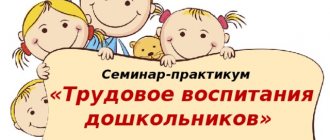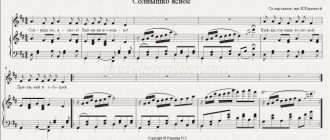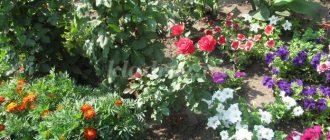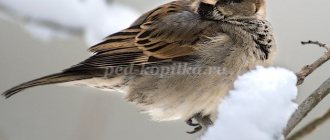Expand the diversity of the educational space with MAAM.
Contained in sections:
- Circle work. Additional education 3812
- Educational programs, basic and additional 5326
- Professional pedagogical education, students 198
By groups:
- Senior group
- Preparatory group
Showing publications 1-10 of 484. All sections | Short-term educational practice. COP in kindergarten
New
Photo
The best
Short-term educational practice “Insects” Municipal autonomous preschool educational institution “ Kindergarten No. 400 ”
Perm Approved by the expert and methodological council of the MADOU
"
Kindergarten No. 400 " in Perm Order No._ from_ Head of the preschool educational institution_
Short-term educational practice for children of primary preschool...
Technological map of the educational program for preschool children "New Year's toy" Technological map of short-term educational practice ( KOP)
optional for preschool children
“New Year's toy”
Abstract In the classes of the developed
short-term educational practice, children will learn how to make bookmarks for books. Purpose Making a bookmark for...
COP “Plasticine insects” (for children of the 2nd junior group)
Municipal budgetary preschool educational institution
"Kindergarten No. 96", Perm
COP "Plasticine insects"
(for children of the 2nd junior group)
Author:
Perm, 2018
Note for parents
Encourage children to want to act with plasticine. Strengthen the skills of rolling a lump of plasticine between your palms using circular movements of your hands. Develop an eye for making large and small lumps, learn to connect them, pressing technique. Help children by pressing (with a ballpoint pen without a refill) to depict the eyes of the bugs. Encourage children to talk about the bug they made. Read A. Prokofiev’s poem “Who is he?” Cultivate accuracy when working with plasticine, patience, and careful attitude towards insects and the results of one’s own and other people’s work.
Program content:
• Form children’s ideas about the inhabitants of their immediate environment, teach them to recognize and name animals based on their distinctive appearance; cultivate interest in the inhabitants of your immediate environment.
• Continue to teach children to pinch off small pieces from a piece of plasticine and roll them into balls with a diameter of 5-7 mm, press the plasticine ball with the index finger, attaching it to the base, place the plasticine balls close to each other, filling the outline image.
• Develop the ability to distinguish and name colors (red, black, green, brown).
• Create an emotionally positive mood, satisfaction from the results of work.
Methods and techniques: surprise moment, demonstration, explanation, questions, joint speaking, showing a sculpting method, showing a sample, individual work, encouragement. verbal, visual, practical, playful.
— Goal: Creating conditions for the development of creative abilities and sensorimotor function in preschool children.
Equipment: plasticine, boards for working with plasticine, outline images of insects for each child, napkins, stacks, rags, insect toys (butterfly, ladybug, caterpillar, dragonfly), modeling examples, modeling patterns, cardboard.
Number of meetings: 4
Number of participants: 10
Implementation period: May 2018
Expected result: Children can name insects and model them according to diagrams.
| № | Class | Tasks | Event plan |
| 1 | Butterfly | -expand and clarify knowledge about insects and their essential characteristics; - clarify knowledge about the benefits and harms of insects for humans; -promote the development of observation, attention, memory, thinking; -activate and expand vocabulary; -develop coherent speech. - instill a caring attitude towards all living things; -notice the beauty of the surrounding nature; - to develop understanding and observance of the rules of behavior when encountering different insects. | Reading fiction by K. Ushinsky “The Cabbage Butterfly” Conversation about insects. Modeling a butterfly. |
| 2 | Ladybug | • Continue to teach children to pinch off small pieces from a piece of plasticine and roll them into balls with a diameter of 5-7 mm, press the plasticine ball with the index finger, attaching it to the base, place the plasticine balls close to each other, filling the outline image. | Surprise moment Breathing exercises Finger gymnastics Conversation Modeling |
| 3 | caterpillar | — development of fine motor skills of the hands; - formation of the thought process of memory, clear speech, visual perception; — consolidate knowledge about the world around us, develop curiosity. Vocabulary activation: bugs, ladybug, wings, head, spots, flower names, large and small lumps, poem | Train travel game Fizminutka Conversation Modeling |
| 4 | Dragonfly | • continue to teach children to sculpt an animal (an insect consisting of several parts, observing the proportions between them; • improve the ability to roll out a lump of plasticine using circular and back-and-forth movements, obtaining objects of round and oval (elongated) shapes (ball, column); • consolidate the ability to divide plasticine into 2 unequal parts; use techniques of rolling, unrolling, connecting parts by smearing; • continue to teach children how to use the stack. • develop tactile sensations, muscle sensations of the fingers, sensitivity of the palms, actions of the hands and the eye; • develop imagination; • develop self-confidence. • cultivate independence in work; • the ability to evaluate the work of comrades; • in the process of helping the character, develop sympathy and empathy. | Conversation Fizminutka Modeling Analysis of works |
Meeting summary 1:
Reading a poem.
(On the table there is a box with subject cards (animals, insects, birds).
The teacher offers the children cards to choose from (the children choose); asks the children: Who found what insect? (children - Bee, ant, butterfly, ladybug, dragonfly, fly, mosquito)
Asks questions: What do all insects have in common? (children - Head, chest, abdomen, 6 legs); When do insects appear? (children - in the spring); Why in the spring? (The sun begins to warm, the day increases, there is a lot of light, plants appear, insects appear); What beneficial insects do we know? What benefits do they bring? (children - ladybug, ant, dragonfly - destroy aphids, harmful insects, help plants. A bee gives honey, a butterfly - pollinates plants); Name the harmful insects. What harm do they do? (children - Mosquitoes and flies carry various diseases, they can infect us.)
Teacher - Well done! Everything was said correctly.
And now I suggest you make a butterfly.
Meeting summary 2: Children stand at random.
Let's greet each other, say good morning! So we started the day with kind words; Let's close our eyes and imagine that we are in a clearing. And in the clearing there are a lot of ladybugs and various insects. Let's try to catch it.
Children repeat the movements shown. They catch with one hand, with the other, with both hands at the same time.
Breathing exercise.
— The ladybug is frozen and cannot fly. Let's warm her with our breath. Children breathe on their palms
- The ladybug has warmed up, let's blow it off our palm.
Children take several deep breaths through their nose and exhale through their mouth. As you exhale, stretch out your lips with a tube and place your palms under the cold streams of air.
The teacher quietly takes out a ladybug: Look who I caught? (Children: Ladybug); Let's look at it. What is she like? (shape, color). Look, the ladybug didn’t fly to us alone. Her friends flew with her. The teacher shows the children contour images of ladybugs (Clarify what they call them in one word - insect); Look, are they as beautiful as our toy - ladybug?; What color are their wings? (colorless, white).
Ladybug, and the guys know a nursery rhyme about you: Ladybug, Fly to the sky. Bring us some bread. Black and white, but not burnt. (children imitate hand movements)
- Guys, do you want a Ladybug like this that will bring you joy?
Finger gymnastics “Ladybugs”
- Now sit down at the tables, and the ladybug will watch how we decorate her friends. Roll small balls of red plasticine and attach them to the backs of the ladybugs.
Children, together with the teacher, sit down and roll balls of red plasticine between their palms, attach them to the base using the pressure method. Kids make 2-4 balls on their own.
— Did you like your pictures? What did you like most?
— Ladybug really liked our place and your pictures, but it’s time for her to say goodbye. Goodbye!
Meeting summary 3:
Progress of activities: Organizational moment
Guys, today we are going on a journey on a train...
V.-Where did the train take us? ...And he brought us to a cheerful, sunny meadow. How beautiful it is here, how clean, fresh the air is, and smells of flowers.
Breathing exercises
(inhale air through your nose and exhale through your mouth)
Educator—Guys, little runners and sunbeams are jumping in the clearing and asking you to catch them (the teacher is holding a mirror in his hand, pointing it at the sun).
(children try to catch sunbeams)
Educator - Well, why didn’t you catch the sunbeams? And I caught, but not a bunny, but some kind of insect. What insects do you guys know?
(children call insects)
Oh, how it tickles your hands - it's an insect. The teacher has a plastic caterpillar in his hands. Children look at the caterpillar.
Educator - Well done, how are we going to sculpt a caterpillar?
Children's answers.
Teacher - (showing children modeling techniques). We roll two balls, a large red one (yellow, orange) and a smaller black one, connect them and glue dots from small pieces of black plasticine. We make eyes on the head - with a ballpoint pen without a refill, press the eyes once or twice. Where do insects live?
Children are on the grass.
Educator - let’s plant them correctly on green grass (green sheet of cardboard)
Meeting notes 4: Conversation with children:
- What insects do you know? (Individual answers from children)
Today a dragonfly came to visit us. But look, children, how sad she is. The fact is that she flew very far from her friends and got lost. Let's help the dragonfly and make new friends for it - dragonflies.
Examination of the sample: Look, children, this morning, so that our guest would not be sad and would have a little fun, I blinded her the same dragonfly. (Consider). So, today in class we will sculpt a dragonfly. Please go to the tables.
II. Working at tables.
a) looking at an illustration with a dragonfly.
Vosp-l pays attention to the posture of children.
Questions for children: What does a dragonfly have? (torso, head, wings, eyes on the head); Where do you think we will start sculpting a dragonfly? (from the body); What shape is the body? (oval, elongated shape); What should be rolled out? (column); How to get a column (first roll out the ball in a circular motion, then roll out the column using back and forth movements; What color is the body? (blue); What shape is the head? (round); How to get it? (roll out the ball); Where are the wings of a dragonfly How many are there? 2 on each side. We will make them from white cardboard.
b) joint work of the teacher and children.
The teacher pays attention to the children’s posture.
Finger gymnastics...
Modeling: We took plasticine and divided it into two unequal parts. Placed on a board (a small part is the head, a large part is the torso); They took a big piece. This will be the body of the dragonfly. Roll out the column; We took a small piece. This will be the head of a dragonfly (roll out the ball); Then we take the torso and head and connect both parts, using the smearing technique.
Physical exercise “Dragonfly”
IV.Work at tables.
- And now we will make wings for the dragonfly. We will make them from cardboard.
— Take the wing (white cardboard) and insert it into the plasticine, smearing it with your finger. Also on the other side.
Working with the stack.
— We make small indentations in the head (these are the eyes).
V. Analysis of children's work.
-Children, please take your dragonflies and plant them on a leaf. Let us look at them and be sure to show them to our guest. That's how many new friends she made. She says “thank you” to all of you for your help.
The teacher praises all the children.
Literature: 1. G. N. Davydova “Plasticineography” Publishing house “Scriptorium”, 2003
2. P. Finger gymnastics for the development of speech in preschoolers - AST Publishing House, 2002
3. Folk art in raising children. Edited by S. Publishing house "Russian Pedagogical Agency", 1997
Get text
Drawing up a technological map by the teacher
Before starting work on the program, the teacher must create a technological map of the COP of a technical focus in the preschool educational institution. It is compiled very simply. To begin, select the name of the activity, for example “Spaceship”, “Merry Men”, “Butterflies”. Indicate the age of the children, the duration of the practice, its tasks, and goals. The resources used and the desired result also need to be included in the map. The last thing that needs to be indicated is what key competencies will be developed in children during the CEP of a technical focus in a preschool educational institution.
An example of such competencies:
- technological - learning to assemble a dog, learning to assemble a car according to a diagram, learning to connect elements into a whole model;
- informational - learn to choose material for work, learn to choose non-standard material for creativity, learn to use information when working with other materials;
- social-communicative - learn to speak correctly with peers and adults, learn to interact with peers.
What tasks does the COP solve in a preschool educational institution?
CEP technical orientation in preschool educational institutions, carried out in preschool institutions, allows you to solve the following problems:
- Educational - children learn various design techniques.
- Developmental - children train logic and thinking, imagination and fine motor skills.
- Educational - the technique allows you to instill perseverance, determination, and patience in a preschooler.
The work can use the methods of observation, examination, demonstration, verbal method and the method of plot games.
All of them are equally effective, but an important condition for the lesson is a well-thought-out plot and positive motivation.
In technical design classes, children create crafts based on real-life objects or fantasize about fairy tales, poems or songs.
Why is a technical COP needed in a preschool educational institution?
Short-term construction practice is very important for children, especially five-year-olds. By creating his own project, the child learns synthesis and analysis, which is so necessary for learning at school. While examining the sample, the preschooler comes up with a new design for it and learns to correct the mistakes made. Such training perfectly stimulates the development of thinking. Games with Lego constructors can be started from the middle group.
Such material will help solve many problems and problems in the development of preschoolers. It must be included in the arsenal of technical-oriented educational programs in preschool educational institutions. “Lego” not only helps develop color perception, logic and spatial imagination, but also activates finger tenacity. The child will not get bored with this construction set, because with its help you can create thousands of different crafts. Preschoolers really appreciate this variety.




